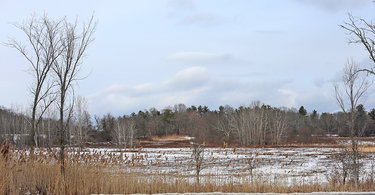New Scotland Town Board passes hamlet zoning, looks to update solar law, names new committee
NEW SCOTLAND — It was a busy last meeting of 2022 for the New Scotland Town Board.
In addition to making major allocations (see related story), board members on Dec. 14 named a new Natural Resource Inventory Committee, passed a long-in-the-works hamlet zoning law update, and set a public hearing to update the town’s solar law.
Solar projects in New Scotland are highly scrutinized, in part because of the way the town’s 2017 solar law was written.
The law says that no large-scale projects are permitted on:
— Land that has prime soils, defined as “land that has the best combination of physical and chemical characteristics for producing food, feed, forage, fiber, and oilseed crops and that is available for these uses”;
— Land that has soils of statewide importance, “where less than 50 percent of the components in the [area] are prime but a combination of lands of prime or statewide importance is 50 percent or more of the [area] composition”; or
— Land that has more than an acre of mature forest, which contains trees that are predominantly six inches in diameter or more.
The update to the 2017 law narrows the prime-soils definition to “Active Agricultural Land,” which is “considered a parcel of land greater than seven (7) acres that within the last five (5) years of the date the application is filed with the Town for a Large-Scale Solar Facility was used for farming, agriculture or nursery. Agricultural uses include, but are not limited to, the production of crops, hay, livestock and livestock products.”
The basic idea is to protect the town’s actual usable farmland, and not have a “blanket prohibition,” Councilman Dan Leinung, the town board’s lead on the local law, told The Enterprise.“So we’re trying to narrow it down or focus it more on the actual use of the agricultural land,” he said.
“The idea is to not have this blanket prohibition on something that hasn’t even been used for farmland for 10, 15, 20 years. It’s just vacant land,” Leinung said. “But at the same time, protecting land that is actually being used.”
The new law does allow for a five-year lookback window, meaning that the land’s use will be examined for the past five years if an applicant is looking to change its use.
The new law does say, if land has had an agricultural use in the past five years then it’s “not qualified” for solar, Leinung said. “But it’s the same thing that we currently do with the prime soils. You have to come in and ask for a variance. It’s a similar thing. It’s generally a prohibition, but you can always come into the board and they can make their determination on a case-by-case basis about that.”
Hamlet zoning
After New Scotland received a now-scaled-down 52-unit proposal on New Scotland Road in June 2021, the town board took up the process of rezoning the hamlet district where the project was located.
The issue for the developer, Richard Long, was the town’s zoning code wasn’t clear as to the allowable density of his proposed development. Representatives for Long at the time argued there were different housing standards in the hamlet district: one standard specified only one home per acre while another allowed a residential unit every 3,000 square feet.
The New Scotland Hamlet is bounded by the town of Bethlehem to the east, the village of Voorheesville and railroad to the west, the Helderberg-Hudson Rail Trail to the north, and commercial and medium-density residential districts to the south of Route 85.
The town board introduced the local law in April to deal with the issue and was due to discuss the bill at its August meeting, but had to push the discussion until September. It then had to push the bill again after receiving further feedback from the town’s planning board on the proposed law.
The new law clears up the old law’s permitted uses.
The new law allows for multi-family housing in the hamlet center subdistrict with a special-use permit. But the housing would be allowed only as part of a mixed-use building and the units couldn’t be placed on the first floor of “any commercial or mixed residential/commercial structure,” according to recently-adopted law.
The new law calculates base density in the hamlet district by using net buildable acreage. This clarifies how the base density is calculated for the hamlet districts by first subtracting the environmental constraints on a parcel (like wetlands) before determining how many residential units can be built on the entire parcel.
In all three hamlet subdistricts — the center as well as the expansion and development areas — the proposed law explicitly states 40 total units would be allowed. However, developers would be eligible for a density bonus “in return for providing certain amenities to the town.”
Resource committee
A little over a year ago, New Scotland was awarded $50,000 from the state that will allow the town to catalog its natural resources and come up with a plan for their future preservation. On Dec. 14, three residents — Christine Galvin, Ed Horn, and Karen Pirozzi — were named to the committee that will begin that process.
The grant is funded by the state’s Environmental Protection Fund, which finances capital projects that protect the environment, and is administered by the Department of Environmental Conservation’s Hudson River Estuary Program.
The Hudson River Estuary Program covers a 153-mile stretch of water beginning at the Federal Lock and Dam in Troy and emptying into New York Harbor.
The funding will allow the town to have all of its natural resources — or the ones it chooses to include, for example, its wetlands, streams, and viewsheds — accessible through interactive mapping, Councilman Adam Greenberg, who spearheaded the initiative for the town, told The Enterprise at the time the award was made, in November 2021.
The mapping will give the town an accounting overview of its natural resources, Greenberg said at the time, “What we have, where. And what we need to be aware of. Do we need to protect certain things? You know, is it OK to have development in a certain area?”
An open-space plan will follow the inventorying of the town’s resources.
The plan is a document that, according to one Ulster County municipality’s plan, “outlines the desired goals for the future preservation and enhancement of both the natural and man-made resources which are important to the quality of life in a community.”
Explaining the resource inventory and subsequent mapping, Greenberg said that, if a resident or applicant to the planning or zoning boards had a question about a parcel of land, the property could be brought up on the mapping software to “see exactly what issues” the property “may or may not have.”
Greenberg said the mapping should streamline any application processes, in addition to being a new tool for the town’s building department.
He cited a hypothetical planning board example where an applicant has been before the board multiple times over the course of a number of months, but then somebody shows up late in the game and says, “But you have wetlands on the back 10 acres” of the property.
“That stuff would all come up as soon as an application” is submitted to the town, Greenberg explained.



